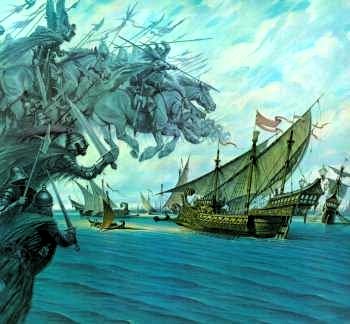THE LORD OF THE RINGS
DEAD MAN of DUNHARROW
(Typical)
Val CHA Cost Roll Notes 12 STR 2 11- 137kg; 2d6 11 DEX 3 11- OCV: 4/DCV: 4 11 CON 2 11- 10 BODY 0 11- 10 INT 0 11- PER Roll 11- 12 EGO 4 11- ECV: 4 25 PRE 15 14- PRE Attack: 5d6 10 COM 0 11- 3 PD 1 Total: 3 PD/2 PDr 3 ED 1 Total: 3 ED/2 EDr 3 SPD 9 Phases: 4, 8, 12 4 REC 0 22 END 0 22 STUN 0 Total Characteristics Cost: 37 Movement: Running: 6"/12" Swimming: 2"/4" Cost Powers & Skills Combat Training: 8 Combat Skill Levels: +1 with All Combat Dead Man of Dunharrow Powers: 2 Damage Resistance (2 PD/2 ED) 15 Does Not Bleed 24 Life Support: Doesn't Eat, Excrete or Sleep, Need Not Breathe, Immune to Aging & Disease, Safe in Intense Heat/Cold 13 Change Environment: Gloom and Mist (2" rad.), 0 END (+1/2), Persistent (+1/2), Always On (-1/2) 10 Detect: Life (+0 to PER), Ranged 25 Spatial Awareness 97 Total Powers & Skills Cost 134 Total Character Cost 75+ Disadvantages 20 Distinctive Features: Walking Dead and Aura of Death (NC) 20 Physical Limitation: Cannot Leave Paths of the Dead without Isildur's heir (All the Time, Greatly) 10 Psychological Limitation: Oath to Isildur (Uncommon, Strong) 9 Experience 134 Total Disadvantage Points

HISTORY
In Second Age 3320, The Realms in Exile (Gondor and Arnor) were founded by Elendil and his sons Isildur and Anarion. Isildur had brought a massive black stone said to have fallen from heaven and placed it at at Erech, at the head of the river later to be known as Morthond (Blackroot) high in the Ered Nimrais (White Mountains).
On this stone, the king of the mountain people swore an oath to Isildur to support him in time of need against the growing power of Sauron. But the mountain people had been followers of Sauron for some time and when the Dark Lord invaded Gondor in 3429, they did nothing. When the Last Alliance of Men and Elves crossed the Misty mountains in 3434, the mountain people broke their oath and refused to make war on Sauron, though they dared not war on the Alliance, either.
For this treachery, and by the power of the oaths which the mountain people had sworn in the names of the Valar, Isildur cursed them to never know death until they should fulfill their oath to him or to his descendants. Isildur died nine years later. Ever after, when one of the mountain people died, he was brought to Dunharrow and the Paths of the Dead, where he lived a life-in-death, waiting down the long millennia for a chance to be released from the world.
That chance finally came more than three thousand years later, during the War of the Ring. Needing speed and allies, Aragorn, the direct descendant of Isildur heeded Elrond's advice to take the Paths of the Dead. The Dead followed him through the tunnel under the White Mountains from Dunharrow in Rohan to Erech in Gondor. There on the oathstone, he gave the dead a chance to redeem themselves from the curse, and they accepted.
They rode with him from Erech to Pelargir, where they overwhelmed the Corsairs of Umbar, who had allied with Sauron and were looting that port city. From Pelargir, the Dead rode with Aragorn to Minas Tirith, where they turned the tide at the battle of the Pelennor Fields. Having finally fulfilled their oaths to Isildur and Aragorn, they at last passed from this world to the Fate of Men.
The dead were physical, trapped undying in their once-living bodies. They were pale and ghostly, however, and a chill mist wrapped them around.
The above is as far as Tolkien takes us in The Lord of the Rings. Iron Crown Enterprise's Southern Gondor: The People goes further, naming the King of the Dead (Morthec Gruan) and identifies the relations of the Oathbreakers to other proto-Gondorian peoples. The Paths of the Dead are identified as "Lugh Gobha", the city of Gobha, a disguise under which Sauron taught the mountain people (the "Daen Coentis") to forge iron and to work stone.
In this work, it is not only the original oathbreakers who are doomed to suffer the fate of undeath, but all their mortal descendants, upon death. The mountain people become a reclusive group, staying near to Erech so that their dead can be properly delivered to Lugh Gobha before they rise to plague the living.
NOTES
1. Tolkien is vague as to whether the Dead Men are physical or not. I have chosen to represent them as physical.